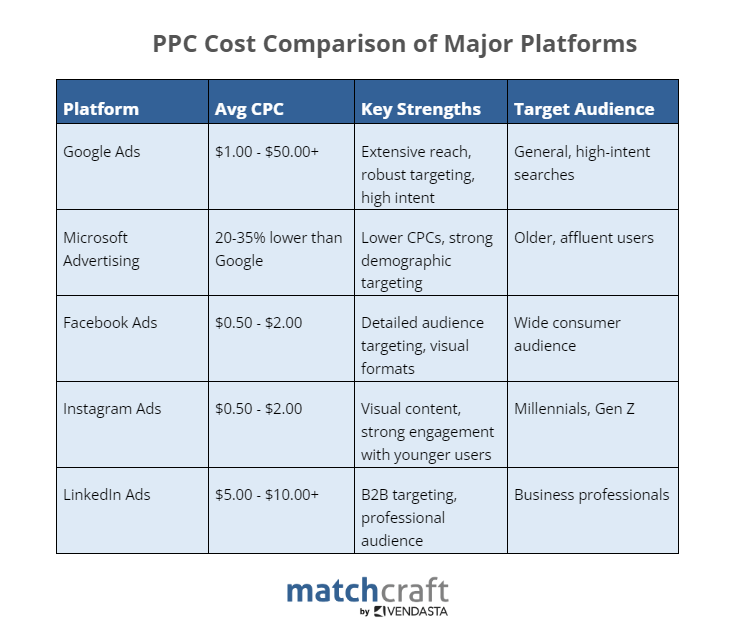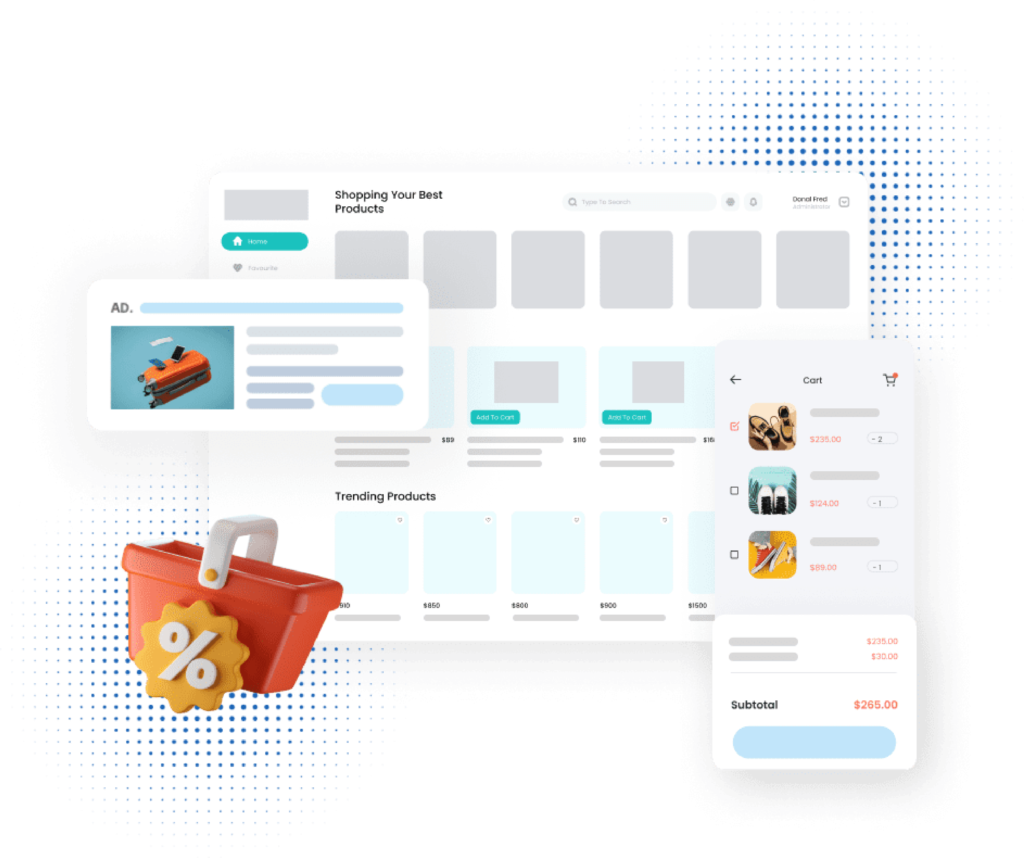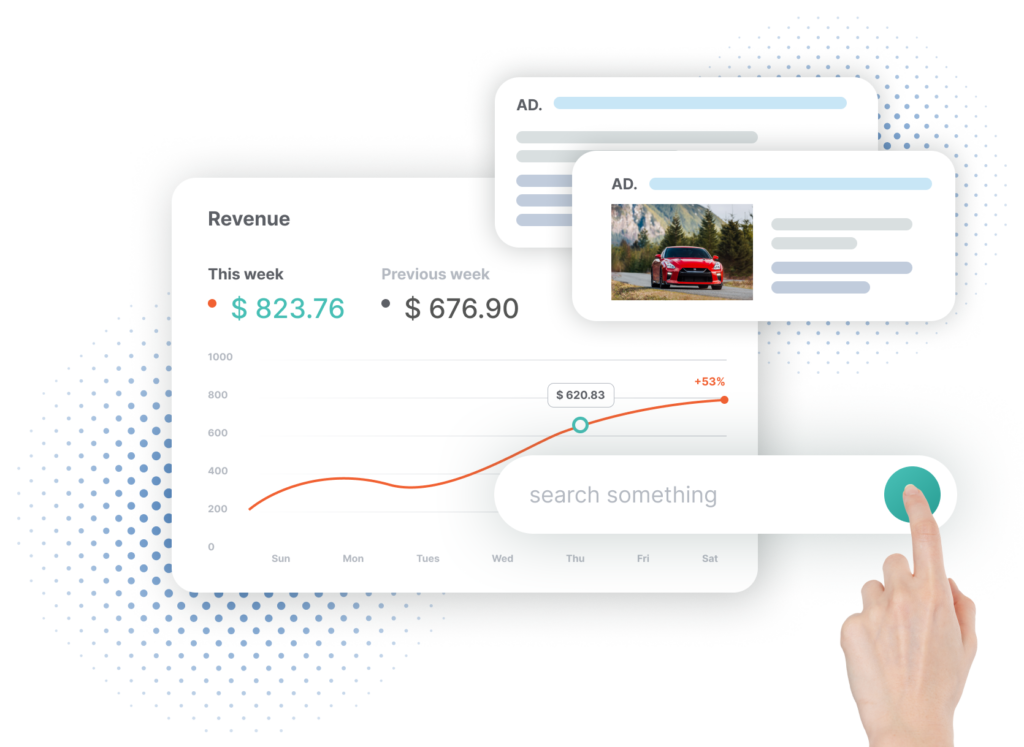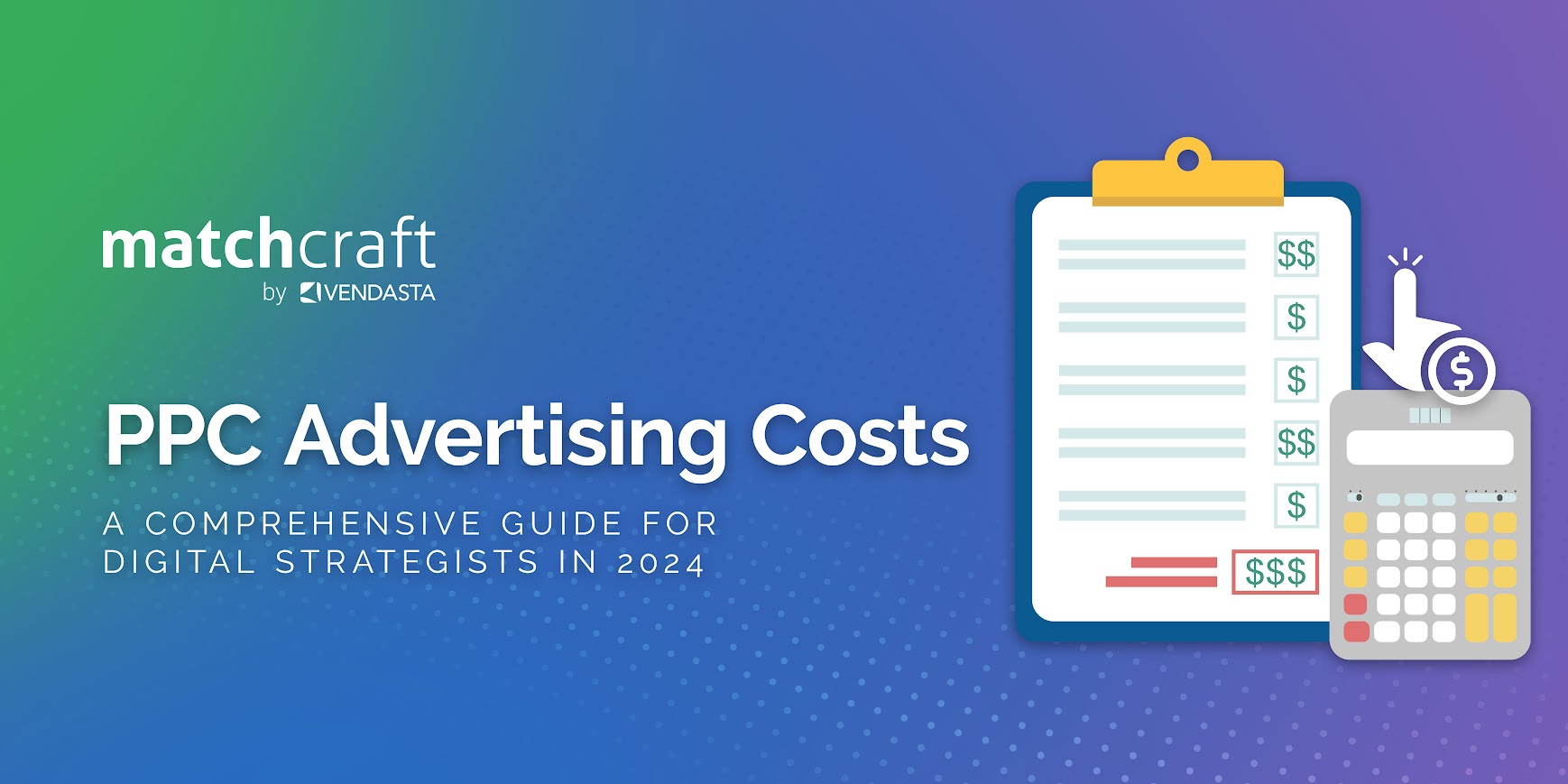Pay-per-click (PPC) advertising has become one of the most favorite and cost-effective solutions for many businesses, making it an almost inevitable choice. You can reach out to the right audience at a relatively low cost.
PPC is a form of digital advertising where you only pay when a user interacts with your ads. These ads can appear as search, display, social, or shopping ads. In 2024, the landscape of PPC is evolving rapidly, with significant fluctuations in costs across various platforms. It’s imperative to grasp the nuances of PPC advertising cost to maximize their return on investment (ROI).
This guide will explore critical aspects of PPC advertising costs, including the factors influencing cost-per-click (CPC), strategies for optimizing ad spend, and tools for monitoring and managing expenses. Additionally, it will provide insights into current PPC trends in 2024 and how to stay ahead in a competitive market.
Average PPC Costs in 2024
PPC advertising costs can vary widely depending on a number of factors, but in general, you can expect to spend anywhere from $100 to $10,000 per month on your campaigns. For smaller businesses, this might seem like a hefty range, but the beauty of PPC is that it’s scalable.
Let’s break down the PPC costs a bit further:
- Cost-Per-Click (CPC): The average CPC in 2024 ranges from $0.11 to $0.50. This means that every time someone clicks on your ad, you’re paying anywhere from eleven cents to fifty cents. CPC is influenced by the competitiveness of the keyword, your ad’s relevance, and the quality of your landing page.
- Cost-Per-1000 Impressions (CPM): If your goal is to build brand awareness rather than drive immediate clicks, you might focus on CPM, which measures the cost per thousand impressions. The average CPM in 2024 will be between $0.51 and $1.00.
Factors Influencing These Averages:
- Keyword Competitiveness: The more in-demand a keyword, the higher the CPC. For example, keywords in industries like legal services or insurance tend to be pricier due to high competition.
- Ad Relevance and Quality Score: Google and other platforms reward well-crafted ads that are relevant to the user’s search. A higher Quality Score can significantly reduce your CPC, making your campaigns more cost-effective.
- Geographic Targeting: Where you’re advertising also matters. Targeting ads to high-demand areas, such as large urban centers, can drive up costs, whereas targeting less competitive regions might lower them.
- Time of Day and Seasonality: Costs can fluctuate based on when your ads run. During peak times or seasonal events (like holidays), competition heats up, and so does the PPC pricing.
PPC Costs by Company Size
When it comes to PPC advertising, one size definitely doesn’t fit all. The amount you spend on PPC campaigns should align with your business size, goals, and resources.
Let’s dive into how and why PPC costs typically vary by company size:
Startups and Small Businesses
PPC is often a game-changer for small businesses because it allows you to compete with larger players without needing a massive marketing budget. Typically, small businesses spend anywhere from $100 to $5,000 per month on PPC.
Small businesses often focus on highly targeted local campaigns or niche keywords that offer a lower cost-per-click (CPC). By carefully selecting keywords and optimizing ad quality, small businesses can stretch their budgets and still achieve significant results.
Read here to learn more about how you can manage your PPC campaigns for small businesses.
Mid-Sized Businesses
Mid-sized businesses have a bit more flexibility in their budgets, with typical PPC spend ranging from $10,001 to $50,000 per month. With more resources at their disposal, these businesses can afford to cast a wider net, running campaigns across multiple channels—like Google, Bing, and various social media platforms—while also targeting multiple geographic regions.
At this level, the focus often shifts to scaling what’s already working. This might involve expanding keyword lists, investing in more competitive keywords, or experimenting with different ad formats like video or display ads.
Enterprises
For enterprises, the PPC budget can vary widely depending on their industry and marketing goals. Some enterprises might spend as little as $100 to $5,000 per month on specific niche campaigns, while others might invest over $250,000 per month to maintain their dominance in highly competitive markets.
Enterprises often operate on a different playing field altogether. They might run national or even global campaigns, targeting broad and diverse audiences. Their budgets allow for extensive A/B testing, sophisticated multi-channel strategies, and continuous optimization to fine-tune performance.
Why Do PPC Costs Vary by Company Size?
The variation in PPC management costs by company size boils down to a few key factors:
- Larger companies often have broader goals, requiring more extensive campaigns across multiple platforms and regions, driving up costs.
- As companies grow, they tend to enter more competitive markets, where the cost-per-click (CPC) can be significantly higher.
- Smaller businesses need to be more cautious with their spending, while larger businesses may have the resources to experiment with new strategies.
- Enterprises often have entire teams dedicated to managing and optimizing PPC campaigns, allowing them to spend more while also ensuring that every dollar is spent effectively.
PPC Costs by Industry
PPC costs aren’t uniform across the board—they can vary dramatically depending on the industry. This variation is primarily driven by the level of competition for keywords.
Let’s take a closer look at how PPC costs differ across industries, and what factors drive these differences.
High-Cost Industries
- Legal: Law firms, especially those specializing in personal injury, are willing to pay top dollar for PPC ads. Keywords related to legal services can cost several hundred dollars per click because landing just one client could mean thousands of dollars in revenue.
- Insurance: The insurance industry is another high-stakes arena. Companies are willing to pay a premium for clicks because of the high lifetime value of a customer.
- Financial Services: Keywords related to loans, credit cards, and mortgages are highly sought after. Financial institutions know that securing a customer can lead to long-term relationships and significant profits, which justifies the higher ad spend.
In these industries, the average cost-per-click can easily soar into the double digits, with some keywords costing over $50 per click. While these costs might seem steep, they’re often justified by the high returns that a single conversion can bring.
Low-Cost Industries
On the other end of the spectrum, some industries enjoy relatively lower PPC costs:
- E-commerce: While e-commerce can be competitive, it’s a vast field with plenty of niche markets where CPCs are more affordable.
- Retail: Similar to e-commerce, the retail industry benefits from a wide range of keyword options.
- Travel and Hospitality: Although popular destinations can drive up costs, smaller, off-the-beaten-path locations might offer cheaper CPCs. Travel agencies or hotels that specialize in unique experiences can find affordable advertising opportunities.
These industries often have lower barriers to entry and less intense competition for specific keywords, allowing you to achieve solid results without breaking the bank.
Factors Contributing to Industry Cost Differences
The value of a keyword is tied to the potential revenue a business can earn from a single customer. In industries where customer lifetime value is high (like legal or financial services), businesses are willing to pay more for clicks.
The more businesses bidding on the same keywords, the higher the CPC will be. Highly competitive industries naturally have higher PPC costs.
In industries where the customer journey is long and involves significant research, businesses might invest more in PPC to stay visible at every stage of the decision-making process.
PPC Platform Comparison: Finding the Right Fit for Your Budget
Choosing the right platform for your PPC campaigns is a crucial decision that can significantly impact your advertising costs and overall success.
Let’s break down the costs and PPC pricing structures of some of the major PPC platforms:
Google Ads Costs and Pricing Structure
Google Ads is the most widely used PPC platform, and for a good reason—it offers extensive reach and robust targeting options. However, with great power comes great responsibility…and cost.
Google Ads operates on a cost-per-click (CPC) model, where advertisers bid on keywords. The cost per click can vary widely depending on the keyword’s competitiveness, with some keywords costing just a few cents, while others, particularly in high-competition industries, can exceed $50 per click.
Microsoft Advertising (Bing Ads) Costs
Microsoft Advertising, formerly known as Bing Ads, is often seen as the underdog compared to Google Ads, but it offers some compelling advantages—particularly when it comes to cost. CPCs on Microsoft Advertising are generally 20-35% lower than on Google Ads, making it an attractive option for businesses looking to stretch their budgets.
While Bing doesn’t have the same reach as Google, it does have a dedicated user base, especially in specific demographics like older adults and those in higher income brackets. For advertisers targeting these groups, Microsoft Advertising can provide a high ROI at a lower cost.
Social Media PPC Costs
Social media platforms have become major players in the PPC arena, each with its own unique pricing model.
- Facebook and Instagram Ads: The cost structure on these platforms is more dynamic, as they are influenced by factors like audience targeting, ad placement, and the time of year. On average, you can expect CPCs to range from $0.50 to $2.00, though highly competitive markets or detailed targeting can drive up costs.
- LinkedIn Ads: LinkedIn is a bit pricier, with CPCs typically ranging from $5.00 to $10.00 or more. The higher costs reflect the platform’s focus on professional audiences, where conversions often have a higher value.

Factors Affecting PPC Costs
Understanding the factors that influence your PPC costs can make all the difference in optimizing your campaigns and getting the best ROI.
Let’s take a closer look at the key elements that can affect your PPC costs:
Keyword Competitiveness: The more businesses bid on a particular keyword, the higher the cost-per-click (CPC) will be. While high-competition keywords can drive significant traffic, targeting long-tail keywords (more specific phrases with lower search volume) can help you capture qualified leads at a lower cost.
Quality Score and Its Impact on Costs: Google’s Quality Score is like a report card for your ads, and it has a direct impact on your PPC costs. The Quality Score is determined by factors like the relevance of your ad to the keyword, the quality of your landing page, and your ad’s click-through rate (CTR).
Ad Relevance and Click-Through Rates: Ad relevance and CTR are closely tied to both your Quality Score and your overall PPC costs. If your ad closely matches the searcher’s intent and offers a compelling call to action, it’s more likely to attract clicks. A higher CTR indicates that your ad is relevant, which can lead to a higher Quality Score and lower costs.
Landing Page Quality: A well-optimized landing page not only converts visitors into customers but also contributes to a higher Quality Score. Google evaluates the quality of your landing page based on factors like load time, mobile-friendliness, and the relevance of the content to the ad.
Geographical Targeting: Where you choose to display your ads can significantly impact your costs. Targeting ads to highly competitive regions, like major cities or affluent areas, typically results in higher CPCs.
Seasonality and Time of Day: During peak seasons—such as holidays or specific industry-related times (e.g., tax season for accountants)—the competition for keywords can increase, driving up costs. Similarly, ads displayed during peak hours, when your target audience is most active, may cost more.
Budgeting for PPC Campaigns
Start by determining your overall PPC budget. This involves understanding how much you’re willing to spend over a given period—usually a month. Once you’ve got that figured out, break it down into daily budgets.
For example, if your monthly budget is $3,000, you could set a daily budget of $100. This approach allows you to control spending and adjust as you monitor campaign performance.
Not all campaigns are created equal, and some will naturally require more budget than others. Identify your top-performing campaigns and ad groups that deserve a bigger slice of the pie. Consider high-value keywords, seasonal campaigns, and news campaigns to allocate your budget wisely.
Tips for Optimizing Budget Allocation
- Regularly Review Performance: PPC is not a “set it and forget it” strategy. Regularly review your campaigns to ensure that your budget is being used effectively. Pause or reduce spending on underperforming campaigns and reallocate those funds to top performers.
- Use Bid Adjustments: Utilize bid adjustments to increase or decrease your bids based on factors like location, time of day, or device type.
- Focus on ROI, Not Just Spend: It’s easy to get caught up in how much you’re spending, but the real focus should be on ROI.
If you’re managing multiple campaigns or clients, leveraging MatchCraft’s AdVantage platform can be a game-changer. AdVantage offers automated bid management and budget pacing features designed to make budget management across various campaigns much more streamlined.

Calculating ROI for PPC Campaigns
Calculating the return on investment (ROI) for PPC campaigns is essential for understanding how well your campaigns are performing and ensuring that your advertising dollars are well spent.
Let’s break down the process of calculating ROI:
Formulas for Determining PPC ROI
At its core, ROI is all about comparing how much you’ve gained versus how much you’ve spent. Here’s a simple formula to calculate your PPC ROI:
Return on Investment = (Revenue from PPC – Cost of PPC) / Cost of PPC x 100
For example, if you spent $1,000 on a PPC campaign and it generated $3,000 in revenue, your ROI would be:
ROI = (3000 -1000) / 1000 x 100 = 200%
This means you’re getting a 200% return on your investment—a solid indication that your PPC efforts are paying off.
Key Metrics to Track
Here are the key PPC metrics to keep an eye on:
- Conversion Rate (CVR): This metric tells you the percentage of clicks that result in a conversion (a sale, sign-up, etc.).
- Cost Per Acquisition (CPA): CPA measures how much it costs to acquire a single customer.
- Click-Through Rate (CTR): This is the percentage of people who click on your ad after seeing it.
- Average Order Value (AOV): AOV is the average amount a customer spends per transaction.
Pro Tip: MatchCraft offers a more simplified and streamlined process to track your ROI with its advanced reporting capabilities. Check out the features of PPC management services for product shopping.

Strategies for Reducing PPC Costs
Reducing PPC costs while maintaining or even boosting your campaign performance is like striking gold in digital marketing.
Let’s explore some smart strategies to make your PPC campaigns more cost-effective without compromising on results:
Improving Quality Score:
- Ensure your ad copy aligns closely with the keywords you’re bidding on. The more relevant your ad is to a user’s search query, the better your Quality Score.
- Your landing page should deliver on your ad’s promise. Make sure it’s user-friendly, loads quickly, and provides a seamless experience from ad click to conversion.
- A higher click-through rate (CTR) indicates that users find your ad compelling, which can positively impact your Quality Score.
Refining Keyword Targeting
- Long-tail keywords are often less competitive and cheaper than broad, short-tail keywords. Although they may have lower search volumes, they tend to attract more qualified leads.
- Use exact match or phrase match to avoid spending on irrelevant searches. Broad match can be useful, but it often leads to higher costs due to irrelevant clicks.
- Keep an eye on your keyword performance. Pause or remove keywords that aren’t driving results, and shift your budget to high-performing ones.
A/B Testing Ad Copy and Landing Pages
A/B testing (or split testing) is a must for finding what works best in your PPC campaigns.
- Test Ad Variations: Try different headlines, descriptions, and CTAs to see what resonates most with your audience. Even small tweaks can lead to significant improvements in CTR and conversion rates.
- Experiment with Landing Pages: Test different layouts, images, or offers on your landing pages. A landing page that converts well can dramatically lower your cost per conversion.
- Iterate and Optimize: A/B testing is an ongoing process. Keep testing and optimizing to find the most cost-effective combinations.
Implementing Negative Keywords
Negative keywords prevent your ads from showing up in irrelevant searches, which saves you from wasting money on clicks that won’t convert.
Use search term reports to see which queries triggered your ads but didn’t lead to conversions. Add these as negative keywords. Plus, continuously update your negative keyword list based on performance data. This helps ensure your budget is spent only on searches that matter.
Tip: Need help to lower your PPC costs? Try MatchCraft’s AI-powered tool to optimize your search ad campaigns effortlessly. Our real-time bidding algorithm boosts revenue by prioritizing high-performing ads.

Future Trends in PPC Advertising Costs
Let’s explore what the future might hold for PPC advertising costs and how you can prepare.
Predictions for Cost Trends in Coming Years
- Increased Competition: As more businesses recognize the value of PPC, competition for popular keywords will intensify. This means higher bids and, consequently, higher costs per click (CPC).
- Ad Saturation: With more ads vying for attention across platforms like Google, Facebook, and emerging channels, the cost of standing out will likely increase. This could lead to more expensive campaigns as advertisers strive to capture the attention of their target audiences.
- Evolving Consumer Behavior: As consumers become more selective in how they engage with ads, advertisers will need to invest in higher-quality creatives and more personalized campaigns, which can increase costs but also improve ROI.
Emerging Platforms and Their Potential Impact on Costs
New platforms are constantly emerging, each bringing its own set of opportunities and challenges for PPC advertisers:
- TikTok and Short-Form Video Platforms: Platforms like TikTok have exploded in popularity, especially among younger audiences. Advertising on these platforms is still relatively new, but as they mature, we can expect costs to rise as more brands jump on board. Early adopters may benefit from lower initial costs and less competition.
- Amazon Advertising: As e-commerce continues to grow, Amazon’s advertising platform has become inevitable for product-based brands. This platform’s ability to target shoppers with high purchase intent makes it a valuable channel for driving conversions.
- Emerging Niche Platforms: Platforms that cater to specific audiences, such as Reddit or Quora, are gaining traction as viable PPC channels. Costs on these platforms are currently lower than on more established platforms, but as their ad ecosystems develop, prices are likely to increase.
Role of AI and Machine Learning in PPC Cost Optimization
AI-powered tools can automatically manage PPC bids in real-time based on the time of day, user behavior, and competition levels. This can help you maximize your budget by bidding more aggressively when it’s likely to lead to conversions and scaling back when the odds are lower.
Machine learning algorithms can analyze historical data to predict future trends, allowing you to anticipate shifts in consumer behavior or market conditions.
AI enables more sophisticated audience segmentation and personalized ad experiences, which can increase relevance and improve conversion rates. While this might initially raise costs due to the complexity of creating highly tailored campaigns, the long-term ROI benefits can outweigh the investment.
If you’re looking for sophisticated and advanced PPC management solutions to scale your PPC agency, contact us to schedule a demo today.
Author: Maria Selvam Amalraj
